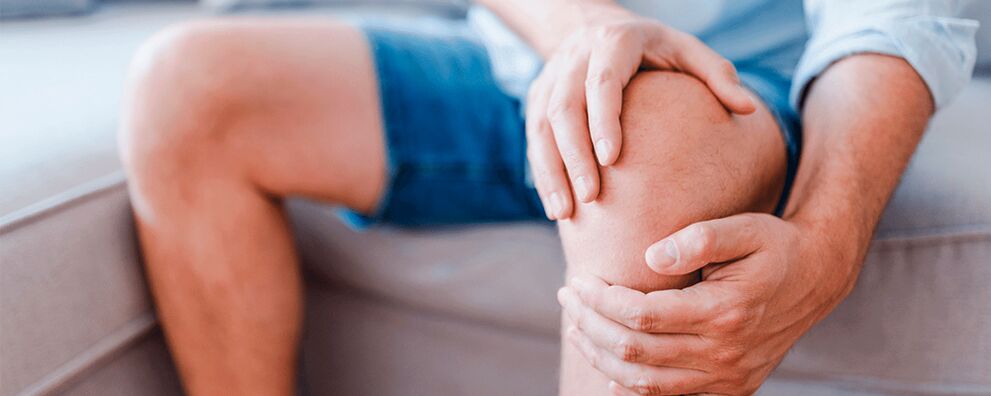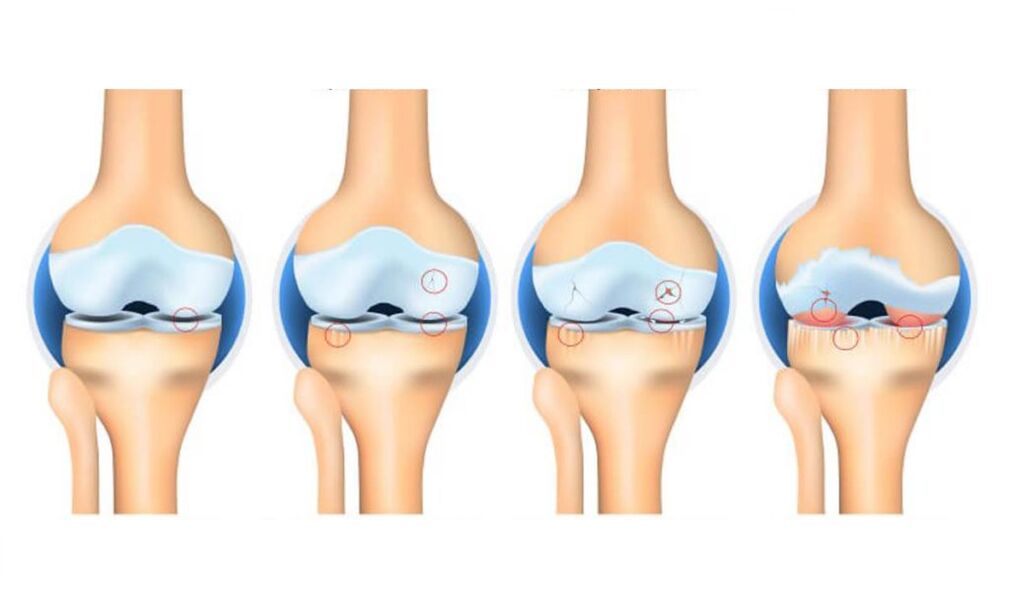
The following factors can contribute to the development of osteoarthritis of the knee joints:
- excessive physical activity that does not meet age requirements, resulting in joint damage;
- sedentary lifestyle;
- suffered injuries in the area of the knee joints - dislocations of the knee, fractures, tears and tears of the ligaments, damage to the body of the meniscus, severe falls on the knee, bruises;
- increased body mass index, which causes increased stress on the joints, rupture of the meniscus;
- inheritance;
- arthritis or other joint diseases (inflammation can lead to the appearance of edema or the accumulation of a large amount of synovial fluid in the joints, causing the destruction of cartilage tissue);
- metabolic disruptions leading to the excretion of calcium from the body;
- diabetes mellitus of any type, hormonal disorders and other pathologies of the endocrine system;
- chronic or previous diseases of an inflammatory and infectious nature;
- violation of blood flow;
- lupus erythematosus, rheumatoid, gouty and psoriatic diseases, ankylosing spondylitis;
- flat feet, due to which the center of gravity shifts and the load on the joint increases;
- nervous overload and stressful situations.
Why arthrosis of the knee joint occurs
Most often, people themselves become the culprits of developing such an intractable disease. Often, when pain in the knee joint appears, people ignore the painful sensations, preferring to go to the doctor to use any medication that simply masks the pain.
After a few years, you will still have to consult a specialist, since with such a diagnosis self-medication will not give results. However, the severity of osteoarthritis will be at least average. Here, ointments, intra-articular administration of hyaluronic acid and preventive physical education are no longer enough, as could be done in the early stages of the course of the disease. Most likely, it will be necessary to take radical action, even sometimes with the use of surgical intervention.
Symptoms and Diagnosis of Osteoarthritis of the Knee Joints
The disease can be distinguished by the following features:
- Pain syndrome. Painful sensations usually occur suddenly, but most often with even mild physical exertion. Pain can be of a different nature. At first, these will be weak lumbago (sadly few people pay attention to them). Mild pain that occurs only periodically can last for months or even years, until the disease develops into a more severe stage.
- Marked deformity of the knee. A similar symptom is typical for the later stages. And at the beginning of the development of arthrosis, the knee swells and swells slightly.
- The appearance of dense formations in the posterior wall of the knee joints. The accumulation of a large amount of joint fluid in the cavity of the Baker's cyst or in the joint itself.
- A sharp creaking of the joints, which is accompanied by pain.
- Decreased joint mobility. This is especially pronounced in the later stages of osteoarthritis. In this case, the flexion and extension of the knee cause severe pain and, in the last stages, the movement becomes almost impossible.
REFERENCE! In a patient with osteoarthritis, the gait changes: it is characterized by lowering of the legs and lameness.
Pathogenesis of arthrosis of the knee joints
Specialists distinguish primary and secondary osteoarthritis.
Primary osteoarthritis of the knee joints
For primary gonarthrosis, the following processes are characteristic:
- Articular cartilage is able to constantly deteriorate and at the same time to renew itself rapidly. Under normal conditions, these two processes should balance each other. As we age, the destruction of cartilage occurs at the same rate, but its recovery slows down. The mass of a person plays an important role here. Indeed, if the mass of a person is 70 kg, then in 10 steps on one leg he will transfer 700 kg, and the one who weighs 120 kg will transfer up to 1200 kg, which will become a significant load on the joints and cartilage, which will wear out faster at because of this.
- It is important to remember: the joint feeds on elements that are useful only when moving. A sedentary lifestyle leads to a slowdown in metabolic processes, which is why the necessary nutrients do not reach their destination.
- The likelihood of developing gonarthrosis increases in people whose parents suffered from this disease.
Secondary osteoarthritis of the knee joint
It develops for the following reasons:
- Multiple injuries. In a person at any age, they will cause undue stress on the cartilage. When a bone covered with cartilage breaks, irregularities appear, the so-called "steps". In this area, now, with any movement, the joint will fade, leading to osteoarthritis.
- Development of rheumatoid arthritis, Koenig's disease, the appearance of purulent inflammation in the joint area.
- Vascular dysfunction.
Classification and stages of development of arthrosis of the knee joints
Orthopedists divide gonarthrosis into stages, on which further treatment of the disease depends. Of course, the course of treatment will also depend on other factors, for example, the reasons for the development, localization and nature of arthrosis.
IMPORTANT! Qualitative treatment can be prescribed by a doctor only after a comprehensive study of the picture of the disease. Self-administered therapy can only exacerbate the health situation.
The main classification divides gonarthrosis into four stages of development:
- Initial state. At this stage, the disease is just emerging. External symptoms are barely noticeable or completely absent, the shape of the joint is in a satisfactory condition. Symptoms include only mild discomfort or heaviness in the knee after long walks, as well as heavy physical exertion. An x-ray examination will be of little information: an x-ray may show only a slight narrowing of the joint space. Unfortunately, at this stage, a person does not seek medical attention due to the insignificance of the symptoms.
- The second stage is characterized by a noticeable pain syndrome, especially when walking and climbing stairs, as well as at night. The severity of the pain decreases at rest. Joint movement becomes difficult. You hear a creak or creak of the knees while walking. On radiography, the narrowing of the joint space becomes evident, as do osteophytes. The patient begins to limp.
- When osteoarthritis has passed to the third stage, the pain syndrome will make itself felt constantly, even in the absence of movement. The processes of deformation and degeneration pass into an irreversible phase. Sprain of the joint becomes pronounced, the distance between the articular surfaces is greatly reduced, numerous osteophytes increase in size. Painful sensations now disturb the patient even in a state of complete rest. A person becomes dependent on external support (walkers, canes) and requires the help of other people. Conservative treatment at this stage is less effective.
- The fourth stage is characterized by constant debilitating pain. Osteophytic growths increase in number and size, the cartilage is completely destroyed, the joint space is barely traced or completely absent, the bones are severely deformed. Even weak movements become torture for the patient. In this phase of gonarthrosis, the patient is recognized as disabled. In the absence of surgery, the disease can lead to disability.

Complications of osteoarthritis of the knee joints
Advanced osteoarthritis can lead to dislocations and subluxations of the knee joint. With dislocation, the epiphysis of the femur extends completely outside the joint, as a result of which movement in the joint becomes impossible and the axis of the leg is substantially shifted to the side. Fortunately, such a negative variant of the development of the disease is quite rare.
Subluxations are more common. They are characterized by a partial displacement of the joints relative to each other and a slight deviation of the axis of the tibia. In this case, subluxations are accompanied by severe pain and joint dysfunction.
Neglect of the disease can lead to a complete loss of function of the lower limb.
ATTENTION! The habit of sparing a sore leg sometimes causes deformation of the intervertebral discs and the appearance of hernias.
Consequences of neglected gonarthrosis
The advanced stage of gonarthrosis is almost always characterized by the following unfavorable symptoms:
- continuous pain, from which no painkiller can save;
- loss of support for a limb (it is impossible to stand on a sore leg or at least to lean on);
- immobilization of the joint block;
- pronounced curvature of the bones around the knee;
- severe swelling around the affected area.
Methods for the treatment of arthrosis of the knee joint
The prescribed treatment depends on the degree of development of the disease. There are several treatment options.
hormones
These drugs are prescribed for severe exacerbations, accompanied by synovitis and severe pain. Hormones are usually given by injection. The following drugs are most commonly used:
- flosterone;
- diprosfan;
- Hydrocortisone.
The course of hormone treatment is usually short; injections are performed only during a period of severe exacerbation. Hormones are administered at an average frequency of once every 10 days.
Chondroprotector
Chondroprotectors are prescribed at the initial stage of the development of the disease. This therapy is currently considered the most effective and safe: there are practically no contraindications, and side effects appear in the rarest cases.
The drugs are aimed at restoring cartilage, improving metabolic processes, nourishing cartilage tissue and protecting it from further destruction. But in the late stages of osteoarthritis, chondroprotectors are also helpless.
This group of medicines is produced in the form of injections, ointments, gels, tablets.
Vasodilator drugs
These funds are necessary to eliminate the spasm of small vessels, increase blood circulation and the supply of nutrients to the affected joint area. Prescribed to take vasodilators together with chondroprotector.
If joint fluid does not accumulate during gonarthrosis (there is no synovitis), it is recommended to use warming ointments.
Hyaluronic acid
In another way, this tool is called intra-articular fluid prosthesis, since the composition of the acid is similar in composition to intra-articular fluid. When acid is injected into the joint, it forms a film that prevents the strong friction of the cartilage during movement, affects the extracellular matrix, improving metabolic processes in the joint and also triggers the production of its own hyaluronic acid in the joint - for example ex. restores the functioning of the joint to normal, stopping the pathological processes that destroy cartilage. . . .
Acid treatment is prescribed only when exacerbation - synovitis is eliminated.
Physiotherapy
A course of physiotherapy exercises will bring positive results only if it is prescribed by a doctor after a comprehensive study of the anamnesis, and all exercises are performed under the supervision of a specialist.
Self-medication often leads to a worsening of the joint situation. Physical therapy is appointed for the following purposes:
- slow down the development of stiffness;
- prevention of further destruction of cartilage tissue;
- elimination of muscle spasm, which leads to pain.
Physiotherapy
As an adjunct therapy, various procedures can be prescribed: electrophoresis, acupuncture, laser therapy, UHF and diadynamic currents. Local massage will also give a good result.
Physiotherapy is aimed at reducing the severity of pain, eliminating inflammation, normalizing metabolic processes within the affected joint and restoring its normal function.
IMPORTANT! It is important for the patient to monitor their diet and avoid strenuous physical exertion.
Forecast. Prophylaxis
With an advanced stage of the disease, the forecasts are disappointing. Therefore, it is recommended that if you are experiencing even minor symptoms of osteoarthritis, you consult a doctor for advice.
People at risk (the elderly, athletes and overweight people) must follow the doctor's recommendations and adhere to the following rules:
- Eat right and monitor your weight. If necessary, follow a weight loss diet.
- Reduce the load on the joints while doing sports, constantly monitor it.
- Promptly treat infectious diseases, preventing their transition to the chronic stage.
- Get adequate rest, avoid stressful situations if possible.
- Increase the protective functions of the body (periodically take vitamins, temper).
- Avoid hypothermia of the body, especially of the lower limbs.

















































